Yoga and its sister science ayurveda are based on keeping the body’s energy balanced and flowing. They value massage as an integral part of supporting that energy and maintaining overall well-being. Chakras (pronounced shah-cruhz, translates as wheels in Sanskrit, due to their spinning form) are a system of seven energy centers aligned along the spine and are responsible for dispersing energy (prana) to all the body’s tissues through 72,000 separate channels. Some of these channels are physical (srotas—intestines, blood vessels, and genitourinary tract), while others are nonphysical (nadis). In the body, the nadis correlate roughly to the nervous system.
The chakras do not exist as structures in the world of gross substances, but are an emergent level of consciousness, dormant until they open during spiritual development. These energies are the basis of all yoga systems. When balanced, they provide human capabilities and health. When out of balance (either because of excess, deficiency, or corrupt energy), they are the cause of disease.
Yoga proposes that the chakras have physical correlates—points of intersection with certain organs, spinal plexuses (networks of nerves), and endocrine glands at each corresponding chakra level in the physical body. They regulate the body from behind the nervous system. Massage affects these glands and the nervous system, bringing out the best qualities of the chakra.
Massage the chakras at each physical location using a clockwise circular stroke, with ghee (clarified butter), which is a good general medium for chakra massage. Chakra massage can be done with medicated oils, which are made by heating base oils (often sesame or coconut) with herbs.
Lower Triangle
The first three chakras are mainly concerned with success and function in the material world—important, yes, but not transcendent. They are sometimes called the animal chakras.
The first chakra regulates basic survival needs and elimination. When healthy, it gives strength and confidence. Massage the coccyx with dashmoola oil, formed with a blend of 10 herbs.
The second chakra regulates creativity, water balance, and sexual functions. If balanced, it gives imagination and healthy sex. Massage the lower abdomen or sacrum with dilute clove or brahmi (gotu kola) oils.
The third chakra is our power center. When flowing, it creates commitment and discipline. Massage the navel area with peppermint and ginger oils.
Human Chakras
The fourth and fifth chakras are concerned with living a happy, healthy, successful life as a human being. The fourth chakra brings compassion and healing energy. When healthy, you connect heart to heart with others and prosper. Massage the center of the chest and upper back with dilute basil oil. The fifth chakra promotes communication. When vigorous, your words inspire. Massage the throat with calamus-infused oil.
Divine Chakras
Beyond the traits of the primordial elements, the last two chakras bring divine qualities into life. The sixth chakra supports intuition and holistic awareness and gives the power to see the unseen. Massage the center of the forehead with rose-infused oil or triphala (an herbal formula made from three plants) ghee.
Thebrings cosmic union when it becomes activated. Massage the top of the head with brahmi (gotu kola) oil.
